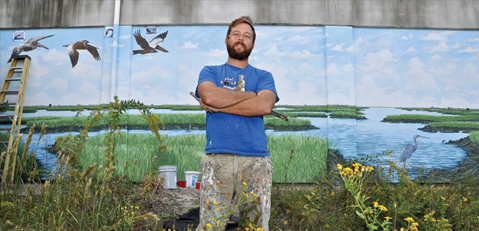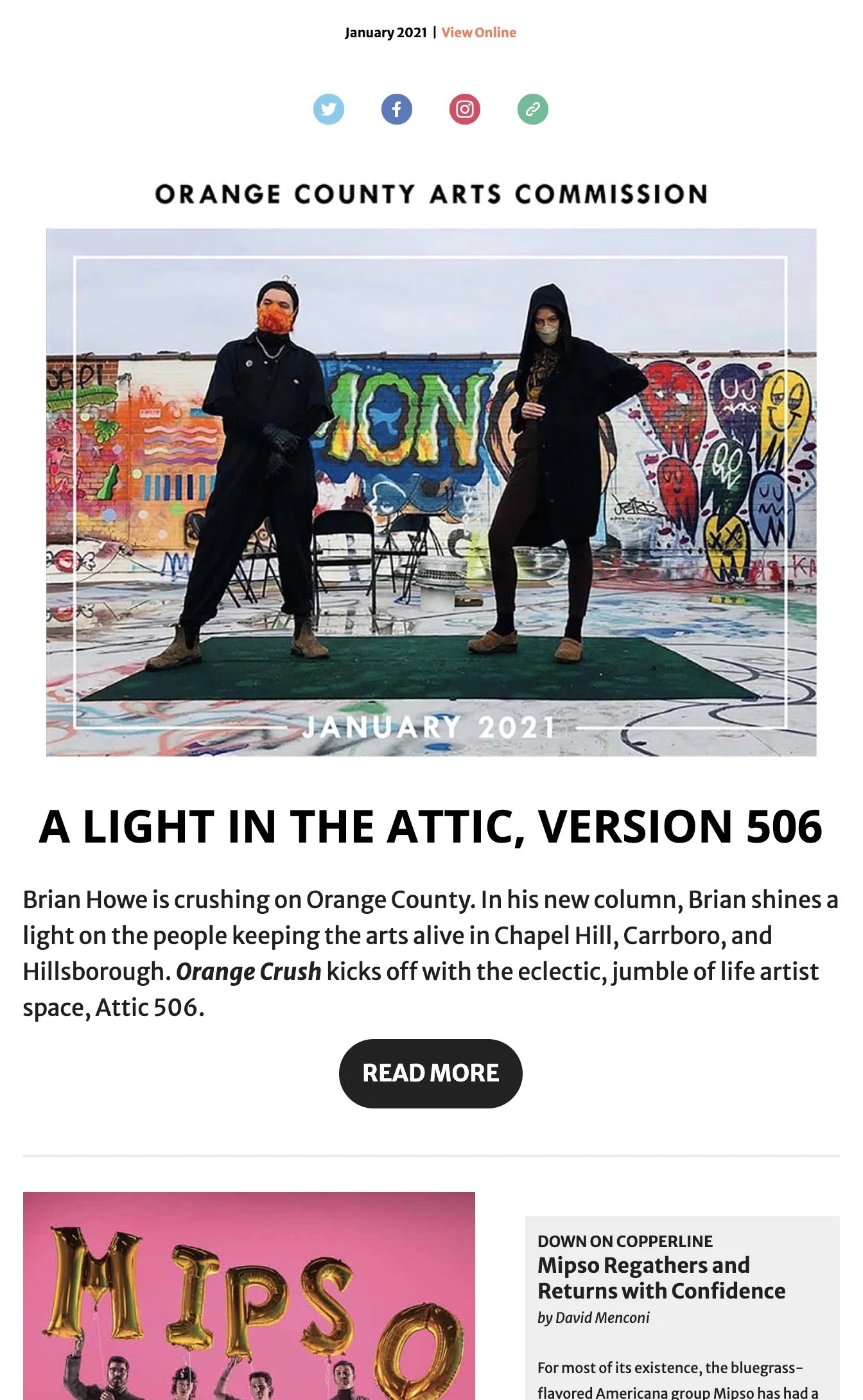
—Article by David Menconi
Chapel Hill resident Scott Nurkin has always led something of a double life – rock-band drummer by night, mural painter by day. While he makes most of his noise as drummer in bands including Birds of Avalon, he makes a living as a painter. It’s enough of a living to support a labor of love, the North Carolina Musicians Mural Project.
The project has taken Nurkin all over the state to paint large-scale outdoor murals of iconic musicians in their birthplace towns including funk singer Betty Davis in Durham, jazz saxophonist John Coltrane in Hamlet, bluegrass banjo master Earl Scruggs in Shelby and pop/soul singer Nina Simone in Tryon. But he didn’t have to travel far to do his most recent mural, because it’s at home in Orange County: Piedmont blues legend Elizabeth “Libba” Cotten at 111 N. Merritt Mill Road, right on the line between Chapel Hill and her hometown of Carrboro.
“I’ve been painting murals professionally for 20 years and there are a lot of jobs where I just want to give up and go have a beer,” Nurkin says. “But I’m so into these musician murals. They’re something I pursued, created myself. This morning, I woke up anxious to get out of bed and get to work on this Elizabeth Cotten one. That’s rare, but I’m thankful for it.”

A native of Charlotte, Nurkin came to Chapel Hill to attend UNC and earned a BFA in painting and drawing. He had plans to pursue a Master’s degree as well, but those were sidelined by playing and touring in rock bands. When he was off the road, he started The Mural Shop, painting distinctive area landmarks including the “Greetings From Chapel Hill” mural postcard on the back wall of He’s Not Here facing Rosemary Street, and the marquee of Raleigh’s Alamo Drafthouse.
His first foray into depicting North Carolina’s musical giants started about a dozen years ago, with a series of smaller portraits on the wall of Pepper’s Pizza on Franklin Street. Researching Thelonious Monk, George Clinton and other North Carolina natives was an eye-opening experience.
“I really dug into the history when I was doing the Pepper’s portraits,” Nurkin says. “Discovered people like John Coltrane, Thelonious Monk, Ben E. King and Charlie Daniels were all from here. People make suggestions all the time. Somebody just contacted me about Little Eva, from Bellhaven, and hell yeah she deserves this recognition. She’s an amazing story, only got paid $25 for (‘The Locomotion’).”
After Pepper’s closed in 2013, Nurkin’s portraits wound up on display on the UNC campus, at the music department’s Hill Hall. But Nurkin was thinking bigger by then, dreaming about expanding to larger outdoor-mural portraits. After years of planning, he kicked off the series this past June, doing all the painting himself without an assistant because, he says, “I’m terrible at delegating, too much in my own head when I’m working.”
The Cotten mural is number eight in the series, and a natural subject (she is also depicted on an indoor wall of Carrboro’s Cat’s Cradle nightclub, painted by local musician Laird Dixon). Born in what was known as the West End in 1893, Cotten grew up playing guitar and wrote the Piedmont blues standard “Freight Train” (a song that is still widely heard today) before she was even a teenager. But Cotten didn’t become a fulltime professional musician until she was in her 60s and “discovered” working as a domestic in the Washington, D.C., home of the folklorist Mike Seeger. She became a beloved regular on the folk-festival circuit before her death in 1987 at age 94.
The Cotten mural is a collaboration between the towns of Carrboro and Chapel Hill, in conjunction with the Chapel Hill Downtown Partnership and coordinated by Backdrop Consulting. Current plans call for around 15 to 20 murals total over two years. Among the murals on tap for 2021 is Link Wray, the pioneering rock guitarist born in the Harnett County town of Dunn.
“You might assume this project is towns finding me to do these murals, but it’s more like the other way around,” says Nurkin. “I don’t care, though. If I had my druthers, this is all I’d do – put aside the commercial work and travel all over North Carolina doing these murals. I don’t want to say I’m ‘educating’ anyone because that makes it sound like I think I’m a teacher. But it makes me happy to let people know about this history.”

